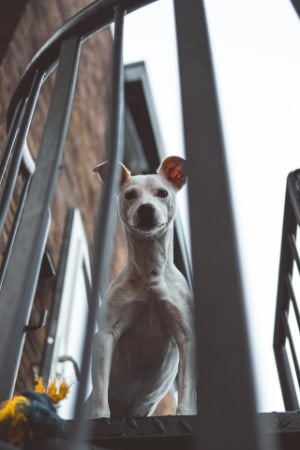A quick look online will show you a few videos of dogs who are afraid of heights- they range from the amusing to the downright cruel, but what they all show is dogs that are clearly petrified on bridges or on stairs.
Personally this is not something that I have experienced much of as a dog owner. The only relevant experience seems to be the attitude of my oldest golden as she crosses a couple of bridges on a walk that we do about once a month.
Both of these bridges are solidly built and are only about 4 feet above the water but as soon as she steps onto them she hunkers down and hesitantly walks or crawls across them.
Can dogs be afraid of heights?

instinct ¹
I think as unlikely as it seems, you dog can be afraid of absolutely anything.
The technical term for a fear of heights is acrophobia from the greek akron (summit) and phobia (fear.)
It is thought that among the human population up to 5% of us have a fear of heights but of course there just isn’t the information available for dogs!
The interesting thing about this is whether dogs have a built in or natural fear of heights or whether they have learned to become scared of heights because of some traumatic experiences.
And the jury is still out when it comes to whether acrophobia in humans is part of our instincts or whether it has been created because of traumatic experiences.
In order to be scared of heights, any animal needs to first have depth perception. A famous set of experiments was carried out in the 1960’s on a range of animals to see if they had depth perception. Human babies and dogs were tested.
In the next section, I take a look at the findings
Visual Cliff
This was a groundbreaking set of experiments that were carried out in the 1960s to find out if human babies had depth perception.
A level surface was prepared that was part checkered flooring and part perspex (with the chequered flooring a few feet beneath.)
Scientists wanted to know if the infants would be as confident crawling over perspex flooring as they were going over the chequered flooring.
The results showed that when babies begin to crawl they are beginning to perceive depth- they are much more hesitant to crawl over the perspex surface than the chequered surface.
What is interesting for us in this article is that before these experiments were carried on human infants, they were carried out on a range of different animals including dogs, cats and cows!
I can’t find any specific findings about dogs but most animals from a very early age have depth perception. In particular, cats at 4 weeks of age showed a real reluctance to go anywhere near the perspex surface.
An exception was rats who were happy to walk over the perspex flooring. The reason for this is that rats primarily use their nose to locate food and rely on their eyesight much less.
However, is depth perception the only factor in a human’s or dog’s fear of height? To explore this a bit more I want to talk about stairs.
Are dogs scared of stairs
This video shows a dog who is scared of climbing stairs being carried up a set of them! And he is not a small dog…
Clearly, lots of dogs are scared of stairs which is a fear that is commonly associated with dogs being afraid of heights.
What is interesting is that these stairs or steps are outside and so they are not enclosed- you can quite clearly see how far off the ground that you are, as you go up and down them.
And another thing is that individual steps do not have a vertical space and so as you are walking up them, you can see the ground below between the gaps in each step.
There is another example of a dog who is terrified of walking up an “open” staircase, in this thread on Reddit.
The owner is quite desperate as she is on the third floor and obviously needs the dog to be a confident user of stairs because they will be using them several times a day.
Her solution came when she found an enclosed staircase to go up and down, which the dog was entirely comfortable with.
Perhaps the dog was much more relaxed when he was on a staircase on which he couldn’t see the ground on his left or right and in between each stair that he climbed!
But why else might dogs be afraid of stairs?
According to iheartdogs.com, there are four possible reasons that dogs are scared of stairs:
- Lack of exposure- your dog hasn’t been up or down enough of them to be confident.
- Traumatic experience- your dog hates stairs because they bring back bad memories. Falling or tripping on them is a common one.
- Learned behaviour- many dogs are taught that they aren’t allowed to go upstairs in a house and then you want them to go up a set of stairs? Come on!
- Pain- a dog doesn’t like climbing or descending a set of stairs because it hurts.
Aside from those 4 reasons stated above and the fact that a dog might have a fear of heights, there are a bunch of other reasons why a dog might not like stairs.
In fact, I can think of four.
[1] Acoustics
Many stairs in communal buildings have weird acoustics because they are empty of any furnishings and they don’t have carpets to soak up the sounds. Dogs with their sensitive hearings are spooked by them.

stairs ²
[2] Slippery wooden floors
Again many of these communal staircases are guilty of this but solid wood staircases are increasingly common in our houses as well. How is Fido meant to grip on that?
[3] Odd textures
Outside staircase might be made of anti-slip material. This might include a metal grid type design or have heavily textured surfaces on the steps, almost like sandpaper. How uncomfortable must that be for a dog.
The bridge on which my dog freaks out has an anti-slip surface on it that must feel like sandpaper. Perhaps it is the texture and not the height.
[4] The elements
Outside steps are open to the elements- wind, rain and ice. All of which bring additional challenges to a dog’s climbing experience.
What can dogs see?
It seems logical that as part of our exploration of dogs being afraid of heights, it is logical to look at a dog’s eyesight in more detail.
As part of this, I want to look at two main areas:
- Binocular vision and depth perception
- Color and night vision
Earlier in this post, I discussed how in order for any animal to be afraid of heights, they needed to have depth perception- which is something that dogs have.
Now, in order to have depth perception an animal needs to have binocular vision.
And that is where I want to start this exploration of a dog’s eyesight.
Binocular vision means that each eye has a shared field of view- part of what we “see” is seen by both eyes.
The close an animal’s eyes to each other, the better their binocular vision (or the bigger the area that both eyes are seeing.)
And the better the binocular vision, the stronger the depth perception.
Dogs have binocular vision but because their eyes are further apart than a human’s eyes, their binocular vision isn’t as great.
And because of this, their depth perception isn’t as great.
Now that we have explored binocular vision, it is time to look at the color and night vision capabilities of a dog’s eyes
It has long been thought that a dog’s eyesight is much worse than a human eyesight and there have been several myths surrounding this, such as dogs do not see in color but only in black and white.
And besides, dogs don’t need such good eyesight because their sense of smell is so strong!
As more research has been carried out into how a dog’s eyes behave, these myths have been shown to be untrue.
Dogs do actually see in some color but it is just not in the vivid colors that we see the world.
And the reason for this is, of course, that they don’t need to .
In any animals eyes there are two different types of sensors, called rods and cones.
The cones are responsible for sensing colors.
There are more cones in a human eye than in a dog’s eye and that is why our color vision is much better than a dog’s.
But, dogs’ eyes have many more rods in than our eyes.
Rods provide “low light” capacity to an eye- the more rods an eye has the better its ability to see at night and the better its ability to detect motion.
It seems to make sense to me that as a predator a dog would need better night vision and motion detection than a human.
An interesting theory about this motion detection is that it is the reason why our dogs are so sensitive to our posture.
And it is true. If I’m stressed or anxious, my dogs pick up on this without me saying anything or making a sound- they can tell from the way that I’m standing or the way that I’m moving.
Having looked in great detail about how dogs view the world, in my next section I want to take a look at the role of fear in a dog’s life and how they get scared.
Why do dogs get scared?
Fear is a very healthy and helpful emotion in all animals, including humans and dogs.
It’s part of a dog’s genetic makeup, an instinctive reaction to danger that helps a dog decide whether it should “fight or flight”.
Because fear is part of a dog’s instinct, it is triggered almost instantaneously to any sign of danger.
And just like humans, we know when a dog is scared because their behaviour changes. We might see them suddenly shaking, pacing, cowering, freezing, growling or barking.
Because fear is an instinctive reaction it is triggered before the brain has had time to think about whether the danger is real.
We might for instance see a dog cowering after a sudden and loud noise, such as hearing a gunshot in the distance whilst on a walk.
But as soon as the dog realises that the sound isn’t an immediate threat it continues to walk normally.
If a dog has a phobia, this is slightly different than an ordinary “fear” reaction.
A phobia in a dog comes as a result of a previous experience. It is an intense and persistent response to a threatening experience.
And therefore, much more difficult to cure (or at least lessen) than an ordinary fear reaction.
Most Common Fears in Dogs
There are 10 widely recognised fears that dogs have. According to iheartdogs.com, they are:
- Thunderstorms
- Fireworks
- Car rides
- Stairs
- The Vet
- Being alone
- People
- Other dogs
- Grooming
- Unfamiliar objects
How to Help dog overcome fear of heights
The way to help a dog overcome any fear whether it be of a thunderstorm or of heights, is to break the experience up into several small steps and to be careful how you comfort/ distract your dog (when they are fearful) or praise them (when they have done well.)
In order to be more specific, I am going to use the experience of helping a dog overcome their fear of going up a set of stairs.
Every dog is different and the longer that your dog has had a phobia of climbing stairs, the longer it will take them to get over it.
You need to break up the task into several smaller steps- no pun intended.
The reason for this is that smaller steps are easier to achieve, which means that you and your dog will succeed far more often and because you are succeeding, you will be using more praise.
Success and praise create a virtuous circle, making more success more likely.
The flip side of breaking a task into smaller steps is that it will take much longer, which might cause you to groan.
But, look at it this way.
How much time have you lost up until now dealing with your dog’s fear? How many sleepless nights have you had? How sore is your back (perhaps) because at the moment you are having to carry them up a set of stairs?
And what is the alternative?!
So on day 1, your target might well be to get your dog within three feet of the first step.
So the question is, how do you deal with their fear and reluctance?
The natural response would be to comfort your dog when they started to shake or cry. But the trouble with that is that you are reinforcing the dog’s feeling that the experience is frightening. Otherwise, why else would you be so loving towards it.
Instead you need to use a bit of distraction and act as if getting to this position is a lot of fun or just really easy.
Does your dog have a favourite toy or a ball that it likes to play with? Use that and turn the experience into a game. Every time that the dog takes a step closer to stairs, praise them and give them a pat.
Then on day 2, either repeat the same aim, or set a slightly tougher aim (standing just in front of the stairs?) or if you didn’t achieve your aim, break it down into even smaller steps.
It is incredibly important that you have lots of patience and that you are kind to yourself and your dog.
And that you don’t give up.
The aim of each day is to achieve a little bit more than yesterday and the reason for this is because your praise is like a drug to your dog- it is one of the things that they crave above all else.
Another part of making progress is that you will not achieve more every single day, some days will be a bit of a disaster but that is OK as long as over time, your dog can climb more stairs…
Photo Credits
¹ Photo by Marc Kleen on Unsplash
² Photo by Glauco Zuccaccia on Unsplash
³
⁴
⁵
⁶
⁷
⁸
⁹





